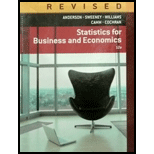
Kiplinger’s Personal Finance Magazine rated 359 U.S. metropolitan areas to determine the best cities to live, work, and play. The data contained in the data set named MetroAreas show the data from the Kiplinger study for the 50 metropolitan areas with a population of 1,000,000 or more (Kiplinger’s website, March 2, 2009). The data set includes the following variables: Population, Income, Cost of Living Index, and Creative (%). Population is the size of the population in 1000s; Income is the median household income in $1000s; Cost of Living Index is based on 100 being the national average; and Creative (%) is the percentage of the workforce in creative fields such as science, engineering, architecture, education, art, and entertainment. Workers in creative fields are generally considered an important factor in the vitality and livability of a city and a key to future economic prosperity.
- a. Develop a
scatter diagram for these data with median household income as the independent variable and the percentage of the workforce in creative fields as the dependent variable. Does a simple linear regression model appear to be appropriate? - b. Develop a scatter diagram for these data with the cost of living index as the independent variable and the percentage of the workforce in creative fields as the dependent variable. Does a simple linear regression model appear to be appropriate?
- c. Use the data provided to develop the best estimated multiple regression equation for estimating the percentage of the workforce in creative fields.
- d. The Tucson, Arizona, metropolitan area has a population of 946,362, a median household income of $42,984, and cost of living index of 99. Develop a prediction of the percentage of the workforce in creative fields for Tucson. Are there any factors that should be considered before using this predicted value?
Want to see the full answer?
Check out a sample textbook solution
Chapter 16 Solutions
Statistics for Business & Economics, Revised (MindTap Course List)
 Glencoe Algebra 1, Student Edition, 9780079039897...AlgebraISBN:9780079039897Author:CarterPublisher:McGraw Hill
Glencoe Algebra 1, Student Edition, 9780079039897...AlgebraISBN:9780079039897Author:CarterPublisher:McGraw Hill Holt Mcdougal Larson Pre-algebra: Student Edition...AlgebraISBN:9780547587776Author:HOLT MCDOUGALPublisher:HOLT MCDOUGAL
Holt Mcdougal Larson Pre-algebra: Student Edition...AlgebraISBN:9780547587776Author:HOLT MCDOUGALPublisher:HOLT MCDOUGAL Big Ideas Math A Bridge To Success Algebra 1: Stu...AlgebraISBN:9781680331141Author:HOUGHTON MIFFLIN HARCOURTPublisher:Houghton Mifflin Harcourt
Big Ideas Math A Bridge To Success Algebra 1: Stu...AlgebraISBN:9781680331141Author:HOUGHTON MIFFLIN HARCOURTPublisher:Houghton Mifflin Harcourt


